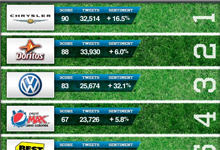For all the measurability of digital publishing, tracking the real impact of social media advertising remains a hope still awash somewhere between art and science.
Brand Bowl, a project organized by a Boston ad agency and presented on Boston.com, used tweets about Super Bowl ads to fashion formulae gauging reach and sentiment for a five-hour window during and after the game.
USA Today ran an ad meter, too, and others tracked the number of YouTube views of each ad as well as such indices as lift to share price.
I’ll focus on Brand Bowl as one index aimed at combining various metrics. Even though social network advertising is expected to account for only about 10 percent of online ads in the U.S. this year, it’s a fast-growing category that news sites will need to do a better job of understanding and explaining to their advertisers.
Relying on selected keywords, Brand Bowl used a monitoring system called Radian6 to track the total number of tweets about a brand advertised during the game; the calculated sentiment about each brand; and overall performance — the “Brand Bowl score” — in the context of all tweets measured. Here’s the math behind each metric:
- Total tweets by brand: Add up all tweets mentioning the brand’s Super Bowl ad.
- Sentiment about each brand: Add positive tweets and netural tweets and subtract negative tweets. Then divide by the number of total tweets about the brand.
- BrandBowl score: Add positive tweets and neutral tweets about a brand and subtract the negative ones. Then divide by 302,977, the number of total tweets for all brands.
The winners? Ads for Doritos captured the first category, Most Talked About, with 34,063 tweets. Ads for Volkswagen emerged as “Most Loved” with a result of 31.1 percent from the calculation described in the second bullet above. And Chrysler’s ode to the struggles of the company and the Motor City took overall honors with the best ratio of net favorable or neutral tweets to all ad-related tweets measured.
The Chrysler ad, in other words, produced the best combination of reach and positive feelings. A commenter on the ad agency’s site highlighted some of the still unanswered questions.
“Stepping away from tweet volume and sentiment,” wrote new media consultant Ari Herzog, “I’m curious if there is a measurable correlation between the above content and 1) money spent on each spot and/or 2) products purchased over the next month. In other words, to what extent will social media help brands see positive ROI after deducting the cost of producing the advertisements?”
It’s too soon to address the heart of Herzog’s question — what’s the long-tail payoff of the ad? — but the Wall Street Journal’s Driver’s Seat blog provided some early indications Tuesday:
Moments after the spot ran during the third quarter of the Super Bowl, online searches for information about Chrysler and the Chrysler 200 spiked on auto-shopping web sites. Edmunds.com reports that research on Chrysler models on its web site jumped 328% after the ad appeared.
Autometrics Inc., a company that tracks activity on more than 100 auto-related web sites, reported that 131 people actually sought price quotes from dealers within 10 minutes of the ad’s airing. By midnight it was up to 839. By comparison, Audi’s commercial for the A8 generated 380 requests for quotes, Autometrics Chief Executive Stephen Shaw said.
I come away from Brand Bowl with a question that’s prompting lots of speculation but no measurement: What was it about that Chrysler ad that provoked such apparent good feeling and engagement to the point of action?
The answers, whatever they may be, hold big implications for news as well as brands in a social, multimedia world.









Comments